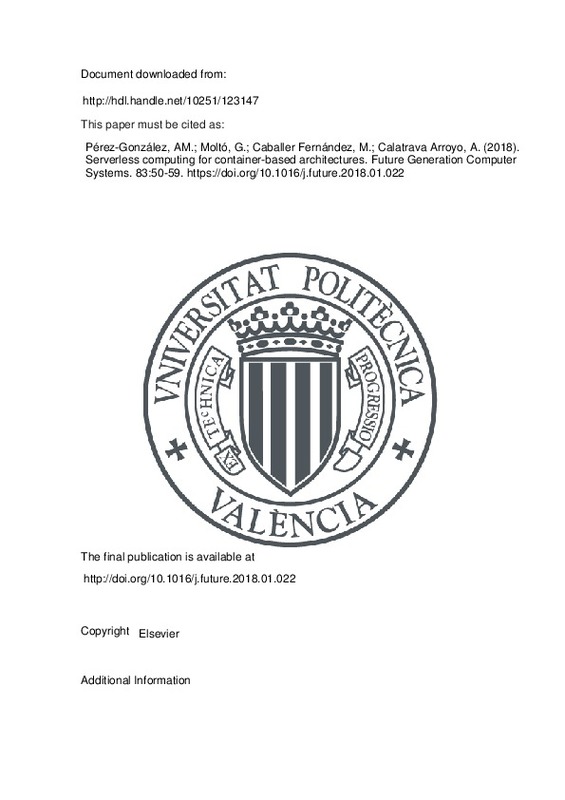JavaScript is disabled for your browser. Some features of this site may not work without it.
Buscar en RiuNet
Listar
Mi cuenta
Estadísticas
Ayuda RiuNet
Admin. UPV
Serverless computing for container-based architectures
Mostrar el registro sencillo del ítem
Ficheros en el ítem
| dc.contributor.author | Pérez-González, Alfonso María
|
es_ES |
| dc.contributor.author | Moltó, Germán
|
es_ES |
| dc.contributor.author | Caballer Fernández, Miguel
|
es_ES |
| dc.contributor.author | Calatrava Arroyo, Amanda
|
es_ES |
| dc.date.accessioned | 2019-07-03T20:03:14Z | |
| dc.date.available | 2019-07-03T20:03:14Z | |
| dc.date.issued | 2018 | es_ES |
| dc.identifier.issn | 0167-739X | es_ES |
| dc.identifier.uri | http://hdl.handle.net/10251/123147 | |
| dc.description.abstract | [EN] New architectural patterns (e.g. microservices), the massive adoption of Linux contain- ers (e.g. Docker containers), and improvements in key features of Cloud computing such as auto-scaling, have helped developers to decouple complex and monolithic sys- tems into smaller stateless services. In turn, Cloud providers have introduced serverless computing, where applications can be defined as a workflow of event-triggered functions. However, serverless services, such as AWS Lambda, impose serious restrictions for these applications (e.g. using a predefined set of programming languages or difficulting the installation and deployment of external libraries). This paper addresses such issues by introducing a framework and a methodology to create Serverless Container-aware AR- chitectures (SCAR). The SCAR framework can be used to create highly-parallel event- driven serverless applications that run on customized runtime environments defined as Docker images on top of AWS Lambda. This paper describes the architecture of SCAR together with the cache-based optimizations applied to minimize cost, exemplified on a massive image processing use case. The results show that, by means of SCAR, AWS Lambda becomes a convenient platform for High Throughput Computing, specially for highly-parallel bursty workloads of short stateless jobs. | es_ES |
| dc.description.sponsorship | The authors would like to thank the Spanish "Ministerio de Economia, Industria y Competitividad" for the project "BigCLOE" under grant reference TIN2016-79951-R. The authors would also like to thank Jorge Gomes from LIP for the development of the udocker tool. | es_ES |
| dc.language | Inglés | es_ES |
| dc.publisher | Elsevier | es_ES |
| dc.relation.ispartof | Future Generation Computer Systems | es_ES |
| dc.rights | Reconocimiento - No comercial - Sin obra derivada (by-nc-nd) | es_ES |
| dc.subject | Cloud Computing | es_ES |
| dc.subject | Serverless | es_ES |
| dc.subject | Docker | es_ES |
| dc.subject | Elasticity | es_ES |
| dc.subject | AWS Lambda | es_ES |
| dc.subject.classification | LENGUAJES Y SISTEMAS INFORMATICOS | es_ES |
| dc.subject.classification | CIENCIAS DE LA COMPUTACION E INTELIGENCIA ARTIFICIAL | es_ES |
| dc.title | Serverless computing for container-based architectures | es_ES |
| dc.type | Artículo | es_ES |
| dc.identifier.doi | 10.1016/j.future.2018.01.022 | es_ES |
| dc.relation.projectID | info:eu-repo/grantAgreement/MINECO//TIN2016-79951-R/ES/COMPUTACION BIG DATA Y DE ALTAS PRESTACIONES SOBRE MULTI-CLOUDS ELASTICOS/ | es_ES |
| dc.rights.accessRights | Abierto | es_ES |
| dc.contributor.affiliation | Universitat Politècnica de València. Departamento de Sistemas Informáticos y Computación - Departament de Sistemes Informàtics i Computació | es_ES |
| dc.contributor.affiliation | Universitat Politècnica de València. Instituto de Instrumentación para Imagen Molecular - Institut d'Instrumentació per a Imatge Molecular | es_ES |
| dc.description.bibliographicCitation | Pérez-González, AM.; Moltó, G.; Caballer Fernández, M.; Calatrava Arroyo, A. (2018). Serverless computing for container-based architectures. Future Generation Computer Systems. 83:50-59. https://doi.org/10.1016/j.future.2018.01.022 | es_ES |
| dc.description.accrualMethod | S | es_ES |
| dc.relation.publisherversion | http://doi.org/10.1016/j.future.2018.01.022 | es_ES |
| dc.description.upvformatpinicio | 50 | es_ES |
| dc.description.upvformatpfin | 59 | es_ES |
| dc.type.version | info:eu-repo/semantics/publishedVersion | es_ES |
| dc.description.volume | 83 | es_ES |
| dc.relation.pasarela | S\351748 | es_ES |
| dc.contributor.funder | Ministerio de Economía y Competitividad | es_ES |







![[Cerrado]](/themes/UPV/images/candado.png)

